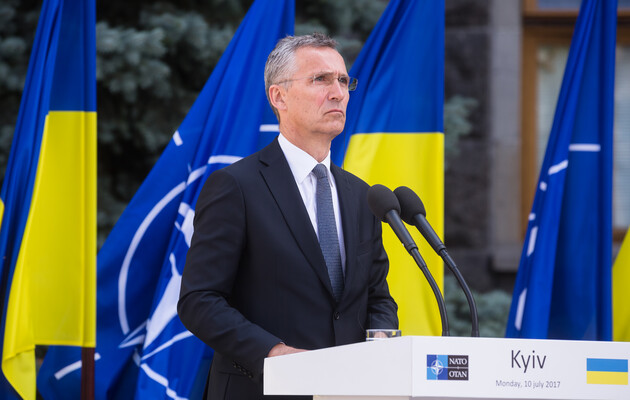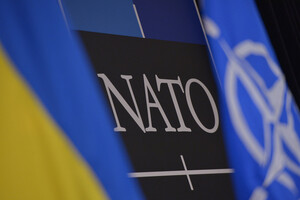How much does it cost to buy off Ukraine?
Against the background of the costs that Europe, the United States of America and the whole world bear as a result of the Russian Federation's attempt to destroy Ukraine by military force, which was never accepted into the North Atlantic Treaty Organization (NATO), the costs of the gigantic expansion that took place since 1997 look insignificant. We will remind, in 1997 there were 16 members in NATO, now there are 31.
The 1990s: We'll cut swords into plowshares, but we won't bring Ukraine into NATO
So, in the 1990s, political figures decided that it was necessary to turn swords into plowshares, that is, it is time to abandon bellicose intentions and live peacefully and amicably, but no one was going to allow Ukraine to join NATO. After all, they decided that it is not advisable and it should not be done.
When in the first half of the 1990s, after intense discussions, NATO politicians made an important decision regarding the membership of the countries of the Visegrád Group (also known as the Visegrád Four, the V4, or the European Quartet), namely Poland, Hungary, the Czech Republic and Slovakia (which, due to the reversal of reforms, missed the first wave of enlargement), the calculations indicated huge costs at that time. They were valued at tens of billions of dollars.
The main expenses fell on changing the nomenclature of weapons and military equipment from the one used during the Soviet Union to the new American and European ones. The most expensive thing was the supply of F-16s for Poland: it cost billions of dollars. It is worth noting that the United States of America gave low-interest loans, actually installments for the purchase of new weapons. In addition, significant amounts of weapons, including "Leopards-2", warships and submarines (albeit not the newest ones) were donated by the European allies.
The worries of the 1990s turned out to be exaggerated. After all, each new wave of expansion was accompanied by increasingly modest rearmament programs. The ability of the new members to bear political, economic and social responsibility for common security came first.
Of course, another spending context should be considered. At the end of his presidency, George Herbert Walker Bush in 1992 proclaimed the era of the peace dividend. At the turn of the 1980s and 1990s, the United States of America defense spending fell from 6% to 3% of GDP. Europeans willingly adapted this trend. The money freed from the plans for war preparations meant the same dividends of peace did not disappear at all, but began to flow into the civilian sector. Similar reductions in military spending took place in the post-Soviet space, with the difference that there the dividends of peace were stolen and disappeared in the chaos of a permanent economic crisis.
Against this background, any costs for the rearmament of new NATO members looked large. The Alliance was expanding not in order to fight, but to erase internal European barriers artificially drawn by the long Soviet occupation of parts of European countries. On both sides of the fallen Iron Curtain, they wanted to become united in their European basis.
2020s: turning plowshares into swords, but Ukraine will not join NATO
This had to be paid for, including rearmament. However, rearmament as such was not the main goal. It is worth noting that 2% of GDP for defense, designated at the end of the 1990s as a political criterion for a decent NATO member, was ready to be sacrificed by only a third of the countries. Countries joined the Alliance, not their armed forces. Moreover, it is worth noting that the Alliance was joined by countries that were democratic and market-driven, governed by the rule of law. Thus, a wave of reforms over the past 25 years has doubled NATO membership exactly, if we take into account Sweden's accession, which will take place soon.
The meaning of expansion was in this wave of reforms. However, it never reached Ukraine. There are many reasons for that. First, the Alliance was able to make sure on more than one occasion that over many years, many high-ranking officials in Ukraine were appointed from Moscow. Secondly, when it came to membership, the rest of the issues could not be delved into.
The 2020s were also marked by the tendency of political figures regarding the idea that plowshares should be forged into swords, but at the same time they still did not want to take Ukraine to NATO.
The 2% of GDP put aside by the Alliance for defense is now actively focused on Ukraine. Political figures in Brussels received the signal of a change of era back in 2014 with the beginning of the occupation of Ukrainian territories by the Russian Federation. But they refused to believe and take it seriously for a long time. The European era of peace dividends lasted until the beginning of the next decade. It was finally canceled only with the beginning of Russia's large-scale invasion of Ukraine in February 2022.
The world has changed, and this has affected global military spending. They stopped fluctuating from crisis to crisis and went rapidly upward everywhere. According to SIPRI estimates, global military spending will increase by 4% to a total of $2 trillion in 2022. According to The Economist publication, which analyzed the military plans of various countries, in particular the accelerated achievement by NATO countries of the level of 2% of GDP on defense, in the near future global military expenditures will increase annually in the range of 200–700 billion dollars (10–30% per year).
The Economist does not rule out that military spending will return to Cold War levels. These are much larger sums of money than today, but still much lower than 10% of GDP even for the countries most involved in the arms race. At this level of military spending, the risks of inflation and recession are not excessive. In general, the International Monetary Fund (IMF) statistics for the last 50 years do not allow us to judge the correlation (positive or negative) between the level of military spending and the rate of economic growth. Military spending in many cases is a government investment in research and development that can later become drivers of economic development. However, there are no more peace dividends and it can only be about optimizing additional military expenditures.
The change of eras caused by the Russo-Ukrainian war, whatever the hopes for post-war growth drivers, has already led to losses in the global economy, half of which is in the United States of America and Europe. Last September, the Organisation for Economic Co-operation and Development (OECD), which unites developed economies, published a forecast that by the end of 2023, as a result of the Russian-Ukrainian war, the world economy will lose 2.8 trillion dollars. It should be noted that this account is not final. In addition, in the near future, the world will allocate more than 2 trillion dollars annually for military expenses, which will grow rapidly.
However, the question arises whether this change of economic eras would have happened if Russia had not unleashed against Ukraine the largest European war since the end of the Second World War? It is most likely that this change of economic eras will not happen. Another question arises: would Russia start a war against Ukraine if Ukraine were a member of NATO? Most likely, it would not have started a war. And one more question, was it possible to solve the problem of the Russian agency in Ukraine, to a lesser extent in Europe and the United States of America, to allow Ukraine to eventually become a full member of NATO? The question is rhetorical. It boils down to who, in fact, should have solved this problem, if not the history of the world itself, which does not tolerate conditional mood, but has the property of repeating itself.
The price of war and peace
According to the Kiel Institute for the World Economy, during the first year of the high-intensity Russian-Ukrainian war (from February 2022 to February 2023), the amount of aid provided to Ukraine on a bilateral basis amounted to approximately 150 billion euros.
Out of this amount, 71.3 billion euros in equivalent aid from the United States of America fell, of which military aid was 43.2 billion, financial – 24.5 billion, and humanitarian — 3.6 billion. EU institutions allocated 35.5 billion euros (military aid – 3.6 billion, financial aid – 30.3 billion, humanitarian aid – 1.6 billion). It was followed by the United Kingdom – 9.8 billion euros equivalent (6.6 billion, 2.9 billion, 0.2 billion), Germany – 7.4 billion euros (3.6 billion, 1.3 billion, 2 .5 billion), Japan – 6.2 billion euros equivalent (military aid – 0, financial – 5.7 billion, humanitarian aid – 0.6 billion), the Netherlands – 3.9 billion euros (2.4 billion, 1 billion , 0.6 billion), Canada – 3.8 billion euros equivalent (1.4 billion, 2.1 billion, 0.4 billion), Poland – 3.5 billion euros equivalent (2.4 billion, 1 billion , 0.2 billion), Norway – 2.4 billion euros equivalent (1.3 billion, 1 billion, 0.2 billion), France – 1.8 billion euros (0.7 billion, 0.7 billion, 0 .4 billion), Sweden – 1.4 billion euros equivalent (1.1 billion, 0.2 billion, 0.1 billion), Italy – 1 billion euros (0.6 billion, 0.3 billion, 0.1 billion), Denmark – 1 billion euros equivalent (0.8 billion, 0.1 billion 0.1 billion).
In April of this year, the mass media widely reported the figure of $200 billion in total aid provided to Ukraine under various expenditure items by the United States of America and European allies. This figure does not contradict the above statements of the Kiel Institute for the World Economy, made for a shorter period of time. Loans at low interest rates given to warring Ukraine by international financial organizations can also be considered as aid.
So, we have a reasonable estimate of the amount of aid Ukraine needs to win the war with Russia for independence and territorial integrity in the amount of 200 billion dollars during the year or a little more. We also have an estimate of global military spending in 2022 at $2 trillion.
Together, its partners are allocating 10% of global military spending for the victory of Ukraine. The question arises: is it possible that our country's membership in NATO will cost less? Certainly yes, given the costs of the last 25 years associated with the expansion of the Alliance. First of all, they related to economic reforms and consolidation of democratic institutions, which should take place in Ukraine.
Of course, in order for Ukraine's membership in NATO to bring cost savings to the world, perhaps even new peace dividends, it is necessary to be sure that such membership will bring long-term peace closer. It is worth noting that there is no consensus on this issue among NATO members.
But the question can be asked differently: what is the Alliance risking by deciding to offer membership to Ukraine as a guarantee of long-term peace? And the answer is that it does not risk anything. First, Ukrainian officials are no longer appointed from Moscow. Second, the remaining risks related to the trust on which NATO's policy rests can be mitigated. But the prize, even if it is not guaranteed, is quite valuable, namely savings of 10% of world military spending.
Read this article in russian and Ukrainian.
Please select it with the mouse and press Ctrl+Enter or Submit a bug















 Login with Google
Login with Google